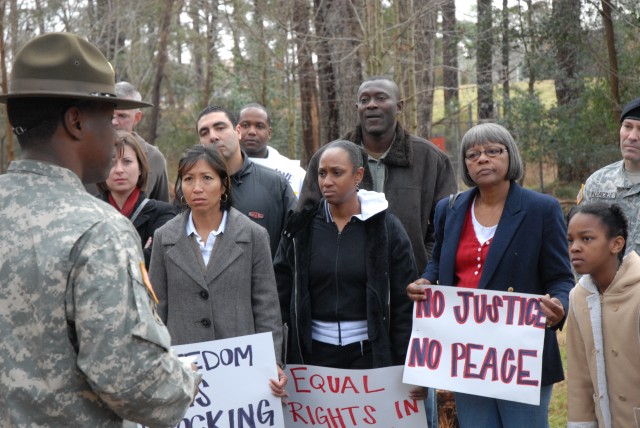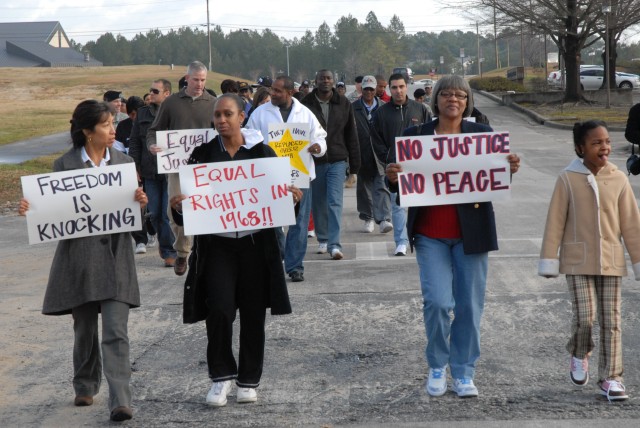FORT JACKSON, S.C. -- Visitors to Fort Jackson last weekend may have noticed a group participating in what, from a distance, looked like a civil rights march.
But the group of Fort Jackson Soldiers, civilian employees and family members gathered at the Solomon Center Feb. 6 were actually honoring Black History Month with the first of two scheduled events.
Some waving signs reading, "Equal rights," "Freedom is knocking" and "No justice, no peace," the community members re-enacted a march commemorating the Orangeburg Massacre, an incident that occurred Feb. 8, 1968, in which South Carolina policemen fired upon a group of college students who were protesting segregation at an Orangeburg bowling alley. Two young men and a 17-year-old-boy were killed that night, while 27 other men and women were injured.
During the re-enactment, participants walked from the Solomon Center to a location near the former Hood Street Elementary School, where they stopped at 11 markers and listened to Soldiers describe the events leading up to and following the 1968 massacre.
Lillie Glover Foxx, military personnel processing assistant for the 171st Infantry Brigade, said even though she was only 14 years old at the time of the massacre, she remembers the anguish of that night as if it happened yesterday.
"The memory never goes away," Foxx said. "The pain, the hurt, it never goes away. It was a sad, bad time. I remember thinking, if it could happen here, it could happen anywhere."
Foxx lived just minutes from where the massacre took place at the campus of South Carolina State University, she said. With almost no media coverage of the events, Foxx said she and her family found out about the killings through friends in her neighborhood.
A freshman at Orangeburg High School, Foxx was one of a small number of black students at the predominately white school. She said she and her friends kept to themselves for a while after the incident, but soon participated in marches at the high school and in surrounding areas.
Foxx said she became passionate about teaching tolerance and making sure events such as the massacre would not occur in the future.
"When something like this happens," she said, "you want to try to do whatever you can to help improve the situation and continue to move forward."
Educating the public, especially younger generations, about South Carolina and its history is what Sgt. 1st Class Chetoria Jackson, equal opportunity adviser for the 165th Infantry Brigade, said she had in mind as she planned Saturday's events.
"We just wanted to bring awareness about something that happened in a place not too far from here," Jackson said, "To show (how) what should have been a simple protest somehow went wrong and had an impact on our culture."
Following the re-enactment, Jackson arranged for a showing of the movie "Separate but Equal," a film highlighting the Briggs vs. Elliot trial, a case that challenged segregation in Clarendon County. It was the first of four cases combined into Brown v. Board of Education, in which the U.S. Supreme Court officially declared segregation unlawful in public schools.
The Fort Jackson community will continue its celebration of Black History Month during a luncheon from 11:15 a.m. to 1 p.m., Feb. 17 at the Solomon Center. James T. McLawhorn Jr., president of the Columbia Urban League, will be the guest speaker.
For tickets, contact Jackson at 751-4247, or call the unit equal opportunity adviser.




Social Sharing